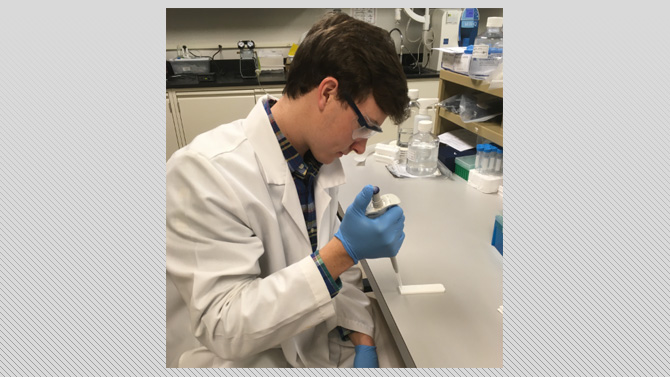


Diagnosing sickle cell
Photo courtesy of Ryan Cleary April 19, 2017
UD, high school students develop new test for disease
A University of Delaware undergraduate and a high school student have developed what they describe as a simple, inexpensive test for sickle-cell disease, a genetic blood mutation that is particularly prevalent in sub-Saharan Africa.
Working under the guidance of research scientist Kris Vaddi, founder and CEO of the biotech startup Prelude Therapeutics housed at UD’s Science, Technology and Advanced Research (STAR) Campus, Ryan Cleary and Vaddi’s son, Tej, devised the blood test designed to screen infants for the disease. They also received guidance and support from CD Diagnostics in Claymont, Delaware.
Cleary, now a sophomore majoring in chemistry and biochemistry at UD, began interning with Kris Vaddi the summer after graduating from Tower Hill School in Wilmington, where Tej Vaddi is a senior.
The Vaddis had been to Africa, where they saw the need for a cheap and easy-to-use test to detect whether an infant has sickle-cell disease, Cleary said, noting that early detection is important.
“Currently, children in Africa [often] go undiagnosed with sickle cell disease and die from complications of the disease without ever knowing they in fact had the disease,” he said.
Sickle cell disease is a genetic blood mutation that results in irregularly shaped hemoglobin cells that resemble a sickle shape. These irregular cells increase the risk of contracting infections, such as pneumonia or meningococcus.
Those with sickle-cell disease can also suffer from painful chronic swelling, jaundice and anemia. The disease affects roughly 3 percent of the population of sub-Saharan Africa.
The test that Cleary and Tej Vaddi created is easy to use and inexpensive to produce, at just 35 cents a test.
“There are four of the materials that go into the device [that] cost $100 each,” Cleary said. “Those materials can produce a total of 20,000 devices. The most expensive part of the device currently is the plastic housing.”
The test requires very few steps, he said. The person conducting it draws a sample of blood, dilutes it with a solution and puts it on the device. After that, the test does the rest.
“In the presence of normal adult hemoglobin, the device will display no line at the test line, and in the absence of adult hemoglobin there is a distinct red line that appears at the test line, which can easily be detected by sight without any equipment,” Cleary said.
The test is able to detect the irregular hemoglobin using an antibody.
“The first antibody that I tested actually was able to differentiate between the normal and disease hemoglobin, which was about a one in a million chance,” Cleary said. His early luck saved their team time and money because they did not have to keep testing antibodies.
But this early luck did not mean that the test came easily.
“I probably created well over 100 different tests, only changing one or two variables at a time,” Cleary said. “The optimal device showed the largest gap of differentiation.”
Right now Cleary and Vaddi are waiting for approval to conduct tests with dried blood samples from newborns to see if their device is working properly. After that, they hope to go to Africa as early as this summer and administer the test to newborns. Their application for a patent is pending.
They are also in the process of finding buyers for their device. Presenting their research to experts and to possible investors has taught both students a lot about the process of starting a company, Cleary said.
But, he said, their success has been even more rewarding for other reasons.
“It has been really exciting to design my own experiments and use past experiments to figure out what the next step should be,” Cleary said. “My favorite part of the research is first and foremost the thought that this little device has the ability to save lives.
“It is one of the most exciting things to be able to know that your research could have a direct impact on others.”
Contact Us
Have a UDaily story idea?
Contact us at ocm@udel.edu
Members of the press
Contact us at 302-831-NEWS or visit the Media Relations website

